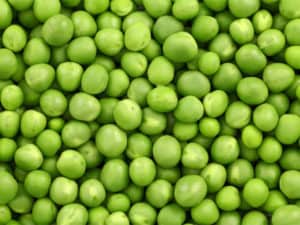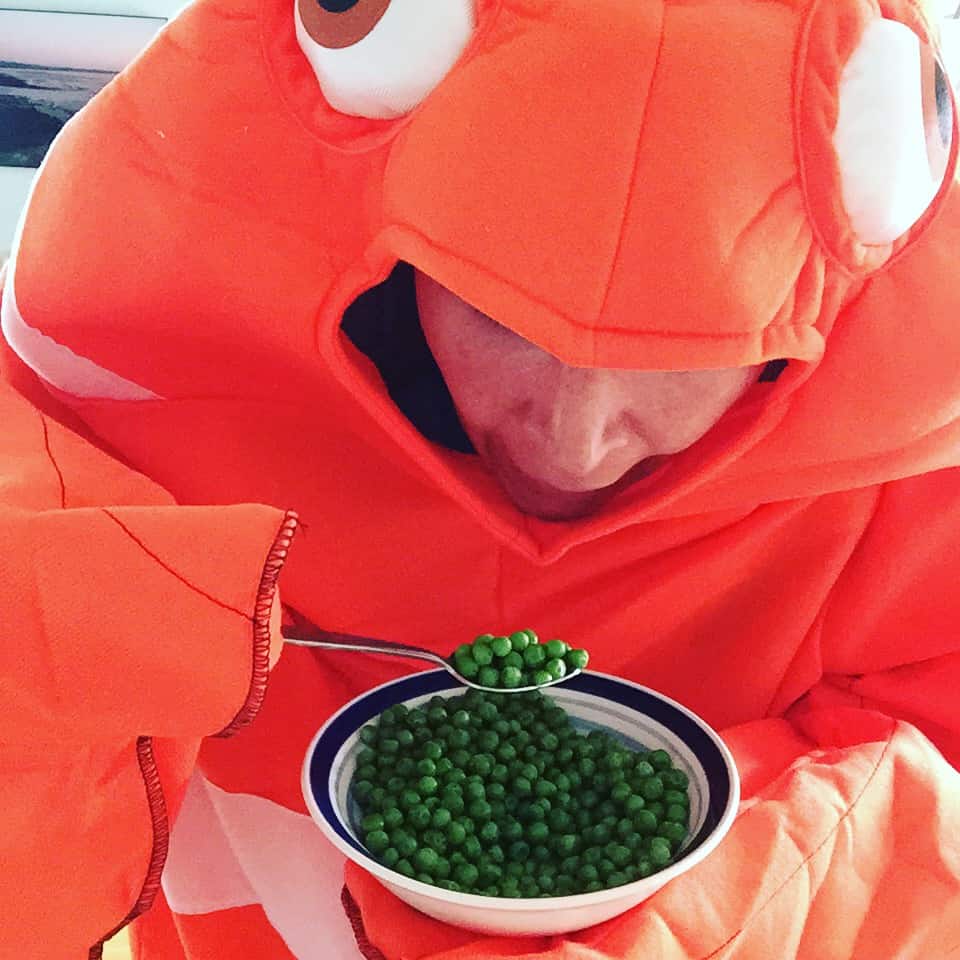“Constipated goldfish” is the most widely over diagnosed case on the internet. Most commonly, goldfish “constipation” is misdiagnosed as a cure all for a sick fish. And in comes the main treatment… feeding goldfish peas! But even with the incorrect diagnosis, your fish gets better! What is going on with these shelled green peas?
But why does feeding goldfish peas make them better if they’re not sick?
Reason #1: Improved water quality
When you feed your fish green peas, they have almost no protein whatsoever, decreasing the amount of ammonia waste from your fish, decreasing the strain on your nitrogen cycle. Decreasing the ammonia waste from your system will make ANY fish better. Every 100 grams of green peas contains 5.4g of protein. Compare that to 100g of commercial fish flake and pellets having between 32-45g of protein.
Goldfish should be maintained on a diet of 30-32% protein. If you are feeding a diet not intended for goldfish, be sure to check your fishes’ food! Tropical fish diets are usually significantly higher and should not be fed to goldfish, no matter how tasty they are. Learn more about the right food to feed your goldfish.
Reason #2: Sinking diet
Green peas sink in water, therefore making fish dive to the bottom of their tank to eat, preventing excess air from ending up in their GI and swim bladder. Goldfish are physostomous, with a duct connecting their esophagus to their swim bladder. Considering the anatomy of some fancy goldfish varieties, these ducts are extremely short and therefore more air is able to get into the swim bladder, causing positive buoyancy issues. When fish eat at the surface, slurping food down like pigs, they can take in a lot of extra air. By feeding fish green peas, which sink, they don’t suck in as much air.
Reason #3: Better quality diet
Goldfish “indigestion” can be caused by an inappropriate diet. Goldfish, like all other carp, are omnivores, eating plants, bugs and almost anything tasty that fits in their mouths. In feeding them a flake or pelleted diet, you are aiming for a balanced diet. There are sooooo many fish foods out there, and a lot of them are based on educated guesses rather than actual research.
The age of your fish’s food will also influence its nutritional value. If you store your fish’s food correctly, you will get about 6 months out of one container. After that, it’s got to go! Feeding your fish green peas can certainly add in missing nutrients your ancient fish food is severely lacking.
As a fish owner, it is up to you to evaluate your fishes’ food to make sure it is appropriate. We have our most watched webinar on this very subject of reading fish food labels. Many of these “constipation” problems are from feeding very old food. After 6 months, your fish food has lost enough of the water-soluble vitamins, including vitamin C, that you are essentially feeding your fish cardboard. Getting a fresh bag of food, or switching the diet to our green peas, fixes almost all of the fish “indigestion” cases we see.
But what about all that fiber?
100g of peas contains 4.8g of fiber and most fish foods contain 3-5g of fiber, so it’s not really all that more fibrous. Not to mention, many pet fish, such as koi and goldfish, don’t have “true” stomachs like us or your fuzzy pets, so it is harder for them to digest fibrous materials. Dried green peas have considerably more fiber due to the decreased water content, but these should not be feed to fish. When added to water, the peas will rehydrate and can cause damage to a fish’s delicate GI tract.
All in all, peas are a low calorie treat that fish can enjoy. But are they magical, cure all tablets of greeny goodness? Sorry, but no.

Other Articles You Might Like
- White Stringy Poop in Fish
- Your Goldfish is NOT Constipated
- My Fish Has “Swim Bladder”
- “Why does my goldfish float after eating?”
- How Many Fish Per Gallon?


Very interesting article..wish I knew that as a youngster…perhaps my goldfish would have had a bettter and longer life!
Pingback: Top 10 Mistakes New Fish Owners Make – #3 – Aquatic Veterinary Services
Best article about PEAS I have ever read. I am an Admin in a large goldfish FB group, We see this like 100 times per day “feed it peas” ……………………for every issue under the sun.
Pingback: How to Be a Better Fish Parent – Aquatic Veterinary Services
Pingback: Top 3 Problems with New Pet Fish & How to Fix Them – Aquatic Veterinary Services
The constipated/green pea diagnosis just won’t die. I fell for it myself, even though I’d never seen it in 20 years of fishkeeping, it seemed reasonable if a bit overdiagnosed. Keep ’em coming, Dr. Jessie!
“Almost no protein whatsoever” is too harsh a statement. Apparently raw mature seeds of pea have almost as much protein as raw beef. Of course if you boil it, the water content will go up to %70 percent, dropping the protein percentage. It’s the same with the fiber.
So, nope, like all legumes, pea is a great source for plant protein and fiber.
Its being overrated as a goldfish panacea might be true, but that’s another matter.
The green peas fed most often by hobbyists are the frozen variety available in most grocery stores. In 100g of peas, you have 3g of fiber, equal to a fiber of 3%. This is about a 1/10th of what normal fish food contains around 30% or higher.
Most fish food is pretty much dehydrated, if I’m not mistaken. That’s why it doesn’t seem to be fair to compare it gram for gram with fresh food full of water, like peas. Indeed, water content of frozen green peas is listed at %80 percent.
If we compared it with carrots instead, we would see that it contained 50% more fiber and 5 times more protein.
But if you argue that, for goldfish plant protein isn’t as beneficial as animal protein, you would be probably right.
Likewise plant fiber might not be as benefical as animal fiber.*
But one must consider the water content before judging the nutritional value of a food.
For instance, we consider milk, which contain %3.5 protein, as a very good source of protein, because we take into consideration its water content.
By the way, I liked your site a lot, despite my pea advocacy. Thanks for all the advices!
* “Animal fiber” is a joke, of course : )
Yes, water content plays a role, but owners are not likely to feed their fish dried peas. 35% protein in fish food is still 35g/100g prior to being eaten. Split peas (dehydrated) have 25% protein, which is significantly higher than shelled, green peas, but not what owners are feeding to their fish.
I keep hearing that peas are used for swim bladder issues in koi. But this makes no sense to me. As the intestinal tracked is not a part of the swim bladder?
It doesn’t make any sense to us either. Technically, the swim bladder is part of the intestinal tract in fish. It is an embryonic outpouching that pinches off in some species, or in physostomous fish, like koi and goldfish, connects through a pneumatic duct. These fish can inflate their swim bladder by ingesting air. By feeding a sinking diet, such as green peas, it prevents fish from feeding at the surface and not taking in as much air. Since koi have a long body shape, unlike many fancy goldfish with stunted, squished bodies, it is unlikely that this duct would malfunction. A koi with “swim bladder” is likely suffering from another primary cause of stress.
Pingback: White Stringy Poop in Fish - Aquatic Veterinary Services
I’m at a loss. I fed my four goldfish some cucumber 3 days ago. I didn’t cook it but sliced it very thin, then slivered those slices very thin. My comet is now (for two days) butt upwards and floating to the top. I’ve never had any issues with her. Her lower abdomen and her vent are slightly swollen, and I’m pretty sure she hasn’t pooped since eating that cuke. So I assumed it was constipation. She has fasted for 2 1/2 days now, and my intention was to continue that until tomorrow, then do the green peas trick. Am I all wrong about this? What else could it be?
I am very sorry to hear about your fish. We do not recommend fasting sick fish unless directed by your veterinarian. https://cafishvet.com/fish-health-disease/why-are-you-fasting-your-sick-fish/ We highly recommend you consult with your local aquatic veterinarian. You can find a local one at https://fishvets.org. If there is no one in your area, please read the following: https://cafishvet.com/fish-health-disease/how-to-find-a-fish-veterinarian/
Pingback: Top 10 Best Natural Fish Foods - Fun Fish Tanks